The election of Adrián Beltré, Joe Mauer, and Todd Helton to the National Baseball Hall of Fame wasn’t the only noteworthy thing about the writers’ ballot results released Tuesday night. As is always the case with the Baseball Writers Association of American ballot, there was a lot more going on below the 75-percent cutoff for induction than above it, and that subterranean action can tell us great deal about which other candidates might be elected in the coming years, and perhaps even when.
It’s important to keep in mind that every BBWAA Hall of Fame ballot contains far more eventual inductees than are elected in that particular year. My favorite example of this is the 2013 ballot. That year, the BBWAA failed to elect a single player, but 10 players from that ballot have since been inducted. The next year, three players were elected, but 11 others have since been inducted via a combination of the writer’s vote (seven players) and the Eras Committees (four more).
The BBWAA voting is a curious phenomenon. Not only do individual writers change their minds about individual candidates from year to year, but as a result of some combination of social psychology, active campaigning, and effects of the passage of time, trend lines in Hall of Fame voting can often tell us a great deal about what to expect in future votes. Indeed, in surveying those trends two years ago, I predicted that Scott Rolen would be elected in 2023 with Todd Helton to follow “a year or two after.” That has since come to pass. So, what can we learn from this year’s downballot vote results? Let’s start at the bottom of the ballot and work our way toward the most compelling returning candidates.
One-and-Done
There were 26 players on this year’s BBWAA ballot, a dozen of whom I can say with confidence will never be elected by the writers. Eight of those players have already had their fate sealed by failing to reach the 5-percent minimum of the vote required to remain on the ballot. All eight of those players were first-year candidates, but six of them received votes, five of the receiving multiple votes, so let’s give them their due here. These are the eight first-year players who failed to reach the minimum 20 votes (out of the 385 ballots submitted) to remain under consideration: José Bautista (6 votes), Victor Martinez (6), Bartolo Colón (5), Matt Holliday (4), Adrián González (3) Brandon Phillips (1), José Reyes, and James Shields.
Being one-and-done doesn’t prohibit a player from eventual election via an Eras or Veterans Committee. Most recently, the Modern Baseball Era Committee inducted Ted Simmons in 2020 despite his having been one-and-done on the writer’s ballot in 1994. However, I don’t think any of these eight players are likely to engender any meaningful Hall of Fame support in the future. Their honor was simply to have been considered.
The PED Plateau
Two other players who will remain on the ballot next year, and seem likely to spend a full 10 years (the maximum number allowed by the Hall) on the writers’ ballot, also appear to have zero chance of election by the writers. Those two are Manny Ramirez and Alex Rodriguez, the only two players on this year’s ballot to have served performance-enhancing-drug suspensions during their major-league careers. Ramirez and Rodriguez both would have been easy first-ballot inductees based on their on-field performances alone, but, as Ramirez’s trend line on the graph below demonstrates, there’s no real momentum to be had for a player with a PED suspension on his record. Ramirez has been on the ballot for eight years, Rodriguez for just three, but its already clear that Rodriguez’s support will also remain stagnant.
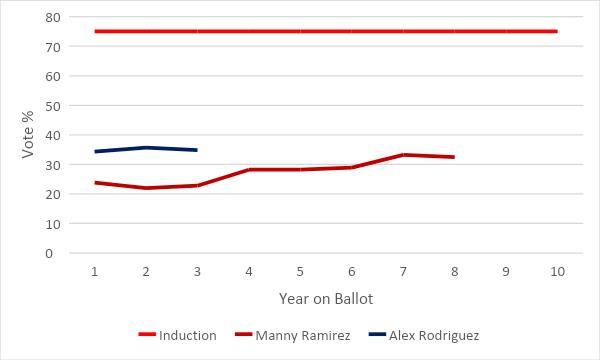
Ramirez does provide us with some important context for the other candidates still to be discussed, however, as his year-to-year fluctuations are a good indication of how crowded the ballot has been in a given year. Most notably, his fourth year on the ballot, which shows a noticeable uptick above, was 2020, a year with a relatively light ballot after years of congestion, as I’ll discuss further below. Similarly, that both Ramirez and Rodriguez have trended ever so slightly downward this year is a good indication that this ballot was more crowded than last year’s. That crowding had a rather devastating effect on one candidate in particular: Billy Wagner, as we’ll see blow.
The Sinking Stone
Before we get to Wagner, however, here’s one more candidate who appears to have no chance of induction via the writers despite the fact that he seems likely to spend all 10 years of eligibility on the ballot. Omar Vizquel’s trend line has been anything but flat:
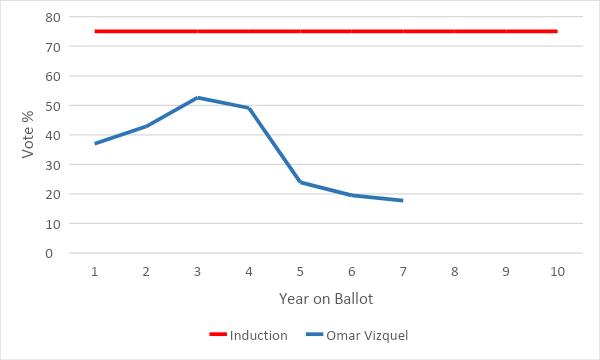
Three years into his candidacy, Vizquel appeared to be well on his way to induction, but allegations of domestic abuse in his marriage and sexual harassment of a minor-league bat boy (which effectively ended his Stateside coaching career in 2019) bent the curve of what had always seemed to me to be a fringy-at-best candidacy. Vizquel has done nothing to repair his reputation since, and he has continued to lose support every year. Last year, Vizquel received 76 votes. This year it was 68. With just three years remaining on the ballot, Vizquel appears to have no hope of induction via the writers.
The Long Shots
Below Vizquel’s 17.7 percent this year lurk five returning candidates—Bobby Abreu, Jimmy Rollins, Andy Pettitte, Mark Buehrle, Francisco Rodríguez, and Torii Hunter—all of whom received enough support to return again next year, but none of whom have shown any meaningful progress toward induction. Here are those five:
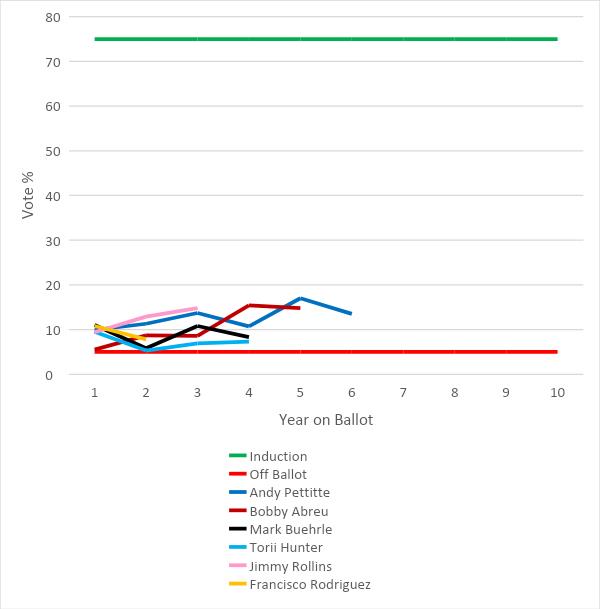
I’ve elongated this graph a bit so you can see each players’ line a bit better, but it’s still a cluster of sub-20-percent support with none of the five trending anywhere close to a meaningful candidacy. Hunter, Buehrle, and Rodríguez, in particular, seem to have a greater likelihood of falling below 5 percent than of getting anywhere near 75 percent. First-year candidate David Wright, who needed 20 votes to remain on the ballot and received 24, thus squeezing in between Hunter and elimination, appears likely to join this group going forward.
Still, with the exception of Pettitte and possibly Abreu, it’s early enough for these candidacies to catch fire. Remember, Larry Walker received just 11.8 percent of the vote in his fifth year on the ballot and 15.5 percent in his sixth year but still got in via the writers in his tenth year of eligibility. That was a highly unusual path to induction, but it’s still worth noting that Abreu, in his fifth year this year, received 14.8 percent of the vote, a better showing than Walker in his fifth year.
Speaking of which . . .
The Late Bloomers
The two players on this year’s ballot who were attempting to follow Walker’s late-surging path to induction both fell short. Billy Wagner, the player I alluded to earlier who was hurt by this year’s more crowded ballot, fell just five votes shy of induction and stands an excellent chance of getting in on his final ballot next year. The other, Gary Sheffield, was on his final ballot this year and simply ran out of time, appearing on 63.9 percent of the ballots and falling 43 votes shy. He’s the twelfth player we can say with confidence won’t be getting in via the writers.
Wagner and Sheffield’s candidacies followed a remarkably similar path, yet one is likely to get in while the other remains on the outside. The key difference might be nothing more than a fluke of timing. Consider this graph comparing the two using the actual year (rather than their year of eligibility) on the x-axis:
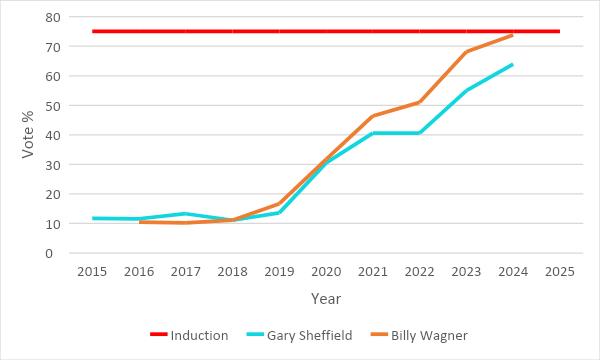
Both were flatlining longshots until 2020. Remember what happened in 2020? That’s when the ballot got a lot less crowded.
In Sheffield’s first five years of eligibility, the writers elected 17 players, averaging more than three per year. In the next four years, the elected just four more. In both 2017 and 2018, nine players received at least 50 percent of the writers’ vote, and eight players did so in 2019. In 2020, that number dropped to six, just two of whom received enough votes for induction (one of them being longtime holdover Walker). In Sheffield’s first five years on the ballot, more than 19 players per year, on average, received at least five percent of the vote. In 2020, just 16 players did. Having cleared 17 Hall of Famers off their ballots in the previous five years, the writers simply had more flexibility to distribute votes to other candidates in 2020, and two of the biggest beneficiaries of that were Sheffield and Wagner.
Both continued to build on that big 2020 surge in 2021, though the lack of a writers’ inductee that year resulted in a crowded ballot in 2022 that briefly slowed their momentum (19 players received at least 5 percent of the vote that year). That late surge and one-year plateau left both candidates with precious little breathing room on their trajectories toward induction, so much so that the advantage Wagner had on Sheffield by virtue of arriving on the ballot one year later appears likely to be the difference between induction and omission.
That said, it’s also entirely possible that Sheffield hit an invisible ceiling this year. It’s noteworthy that Sheffield, who has admitted to performance-enhancing-drug use (brief and inadvertent, in his at-times contradictory accounts), maxed out at 63.9 percent this year, just shy of where Barry Bonds (66 percent) and Roger Clemens (65.2 percent) topped out in their tenth year on the ballot. Perhaps no more than two-thirds of the electorate is willing to overlook such a substantiative connection to PED use, however inadvertent or circumstantial, and Sheffield would have plateaued there no matter how many years he had remaining. After all, Wagner got a larger percentage of the vote last year (68.1 percent) than Sheffield got this year, so Sheffield was really more than a year behind Wagner’s pace coming into this season.
Still, Sheffield’s late surge would seem to make him a strong Eras Committee candidate. In recent years, we’ve seen Jack Morris, Alan Trammell, Lee Smith, and Fred McGriff all receive quick induction via the Eras Committees after falling of the writer’s ballot. Jack Morris topped out at 67.7 percent and was inducted four years after falling off the writers’ ballot. Trammell topped out at 40.9 percent and was induced two years later. Smith topped out at 50.6 percent and was inducted two years after falling off the writers’ ballot, and McGriff topped out at 39.8 percent and was inducted four years later. The Contemporary Baseball Era Players’ Committee will next vote on inductees for induction in 2026. Sheffield’s strong finish on the writers’ ballot would seem to make him a strong candidate to at least receive consideration from that Committee.
As such, Gary Sheffield may yet be a future Hall of Famer, but I can’t say that with as much confidence as I can about these three:
The Future Hall of Famers:
The trend lines tell you most of what you need to know here:
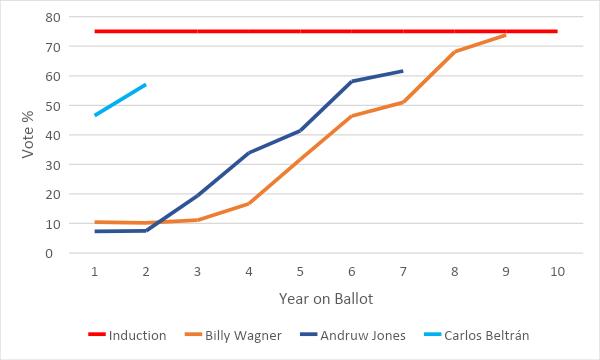
I’ll be shocked if Wagner doesn’t get those five missing votes (or the percentage equivalent) next year.
Andruw Jones has made steady progress since his third year on the ballot (which, you guessed it, was 2020) and is on pace to get in on one of his final two ballots in 2026 or ’27.
Meanwhile, Carlos Beltrán’s strong debut and significant gain this year despite a crowded ballot (up nearly 11 points to 57.1 percent) suggests he’ll be inducted before he’s half way through his eligibility.
The 2026 ballot looks to be another thin one, with few candidates who seem likely to even surpass five percent of the vote (Ichiro Suzuki and CC Sabathia top 2025’s list of first-year candidates, but Cole Hamels is the career WARP leader among 2026’s first-timers), so it seems reasonable to expect center fielders Beltrán and Jones both go in that year.
That’s three more Hall of Famers on this year’s ballot, with Sheffield a potential fourth should the Eras Committee look upon him kindly. And there’s one other player from this year’s ballot whose vote total also suggests an excellent chance of eventual induction: Chase Utley.
As a first-time candidate this year, Utley received 28.8 percent of the vote. That may not seem terribly impressive (it’s barely more than a third of what he needs for induction), but it’s a very strong showing for a first-year candidate. The only candidates on this year’s ballot who received a higher percentage of the vote in their first year and have not yet been inducted are Manny Ramirez, Alex Rodriguez, and Omar Vizquel—all of whom have extenuating issues—and Beltrán, who appears to be on pace for induction. Utley received a larger share of the vote in his first year than recent inductees Todd Helton (16.5 percent), Scott Rolen (10.2), Larry Walker (20.3), Mike Mussina (20.3), and Tim Raines (24.3), not to mention Wagner (10.5) and Jones (7.3), who also seem to be on track. It’s too early to trace his trend line, but based on his qualifications and strong start, I’d put Utley on the list of future Hall of Famers, as well. If I’m right, it will once again be true that there were more Hall of Famers below the 75 percent cutoff on this ballot than there were above it.
The post Tracking the 2024 Hall of Fame Results appeared first on Baseball Prospectus.
https://www.baseballprospectus.com/news/article/87867/tracking-the-2024-hall-of-fame-results/
 Backyard GrillingWeekend WarriorsAdvice from DadBeard GroomingTV Shows for Guys4x4 Off-Road CarsMens FashionSports NewsAncient Archeology World NewsPrivacy PolicyTerms And Conditions
Backyard GrillingWeekend WarriorsAdvice from DadBeard GroomingTV Shows for Guys4x4 Off-Road CarsMens FashionSports NewsAncient Archeology World NewsPrivacy PolicyTerms And Conditions
